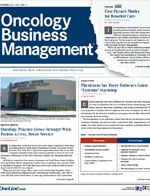Alternative Payment Plan Focuses on Relevant Clinical Outcomes
As long as bundles are tied to a desired clinical outcome of relevance to the patients, we can truly move toward value-based medicine and enable the Goldilocks formula of delivery: just the right amount of care, not too much, and not too little-every time.
Andrew L. Pecora, MD
It would seem straightforward: you define a disease category, review the data on expected outcomes following an accepted approach, and do it the same way every time for a fixed price. This approach has been successful in knee and hip surgery and in the management of other disease categories. In fact, we have been using the single price, bundled care method for over 20 years for stem cell transplantation. So why is there resistance in the remainder of oncology? The list of barriers is now coming into focus. The largest remains the proper categorization of patients and their specific diseases for an accounting of all relevant comorbidities and prognostic variables.
In stem cell transplantation, the type of procedure (ie, autologous blood stem cell vs allogeneic cord blood transplant) has a much greater impact on clinical and cost outcomes than the underlying disease. Thus the field was able to set up “bundle levels” without the need to factor in disease characteristics or comorbidities. Level 1 bundles are autologous blood stem cells without radiation, while level 6 bundles are cord blood or unrelated, mismatched transplants. Level 1 bundles cost less and have less variance than level 6 bundles. This approach in transplant medicine has greatly simplified billing and collection, and everyone on all sides understands the economic risk involved. With regard to nontransplant oncology, the diversity of disease and the lack of refined characterization of comorbidities using ICD-9 or ICD-10 is an issue and needs to be resolved.
Once a physician or hospital system believes that their patients are no sicker than those with whom they are being compared, then and only then can oncologists take the next step toward bundled reimbursement, and that is paying for what matters most to clinicians and patients: relevant clinical outcomes. Regional Cancer Care Associates (RCCA), an organization in which I serve as president, has launched bundles in adjuvant breast cancer, adjuvant colon cancer, and metastatic lung cancer. We work with the payers to precisely define the comorbidities and clinical molecular characteristics relevant to outcomes by using the Cancer Outcomes Tracking and Analysis (COTA) Nodal Address system. We then track the outcomes.
When the intent of therapy is curative, we track and are reimbursed through shared savings for delivered dose intensity, ECOG performance status, and progression/disease-free survival and overall survival (OS) benchmarked against national databases. RCCA and the payers have agreed on the expected outcomes based on evidence, and we have also agreed to adjust therapies if they are more costly and do not improve outcomes, as well as to add new therapies when supported by evidence. When the intent of therapy is palliative, we track a new Living with Cancer Score developed by COTA that includes performance status and psychosocial and economic parameters reflecting the patient’s interest in continuing therapy and progression-free survival and OS.
Some practices may not have the informatics ability to capture and report this information. In addition, moving away from the comfort of being paid on a unit of activity basis to an average-based single payment (ie, paid the same for 10 visits for a sick patient and 2 for someone without issues) may be a challenge for some. Moreover, oncology care does not exist in a vacuum. Payers and systems are moving to organized care delivery in primary care and other specialties. Attempting to merge all these activities into a coherent approach for individual geographic areas will be a challenge.
However, a single payment for a period of care of 6 months or 1 year, with the physician deciding how many visits and not needing to care about the level of service charge or whether he documented a 10- system review, can be rewarding in itself. In addition the cost and complexity of billing and collection can be reduced. Most important, as long as bundles are tied to a desired clinical outcome of relevance to the patients, we can truly move toward value-based medicine and enable the Goldilocks formula of delivery: just the right amount of care, not too much, and not too little—every time.




